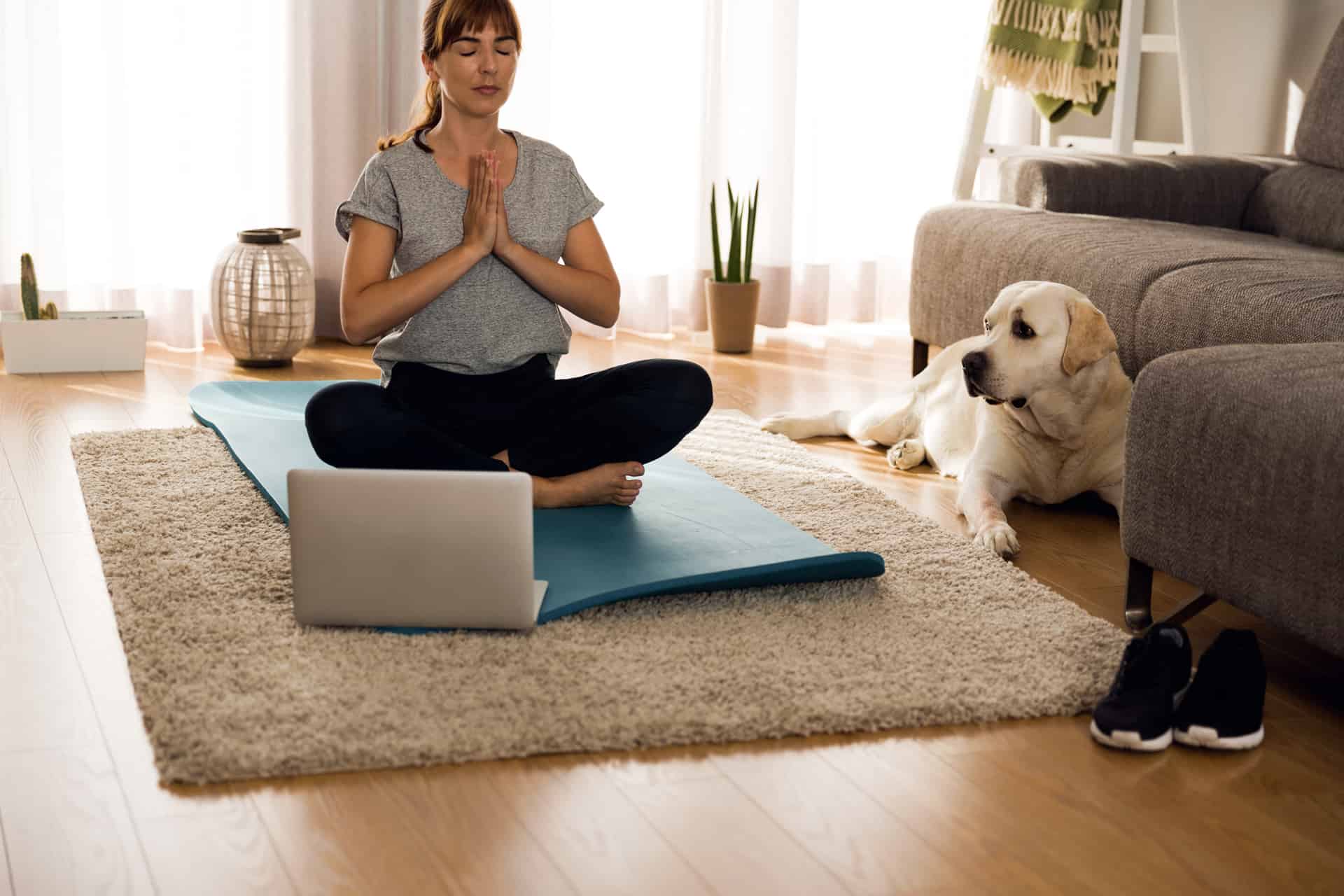Canine Meditation: Teach Your Dog to Find Inner Peace
Canine meditation is a great way to help your pup find tranquility. It can reduce anxiety, boost focus, and give better sleep. To get started:
- Find a quite spot with no distractions.
- Sit on the floor with your pup, close your eyes and focus on your breath.
- Put a hand on their back and gently stroke.
- Then, visualize peaceful imagery and let them join in.
- Keep the sessions short at first.
- With practice, your pup will learn to connect and benefit from meditation.
What is Canine Meditation?
Doggy meditation is a fantastic way to give your pup inner tranquility. This custom can decrease worry and raise overall health, and also instruct your pooch the strength of stillness. Additionally, it’s an awesome approach to share with your pet and make a deeper relationship. Let us take a closer look at what pup meditation is and how to get started.
Understanding the Benefits of Canine Meditation
Canine Meditation: Teach your pup to find inner peace using deep breathing, mindfulness and visualization. You and your pup can both enjoy the benefits!
Benefit #1: Stress & Anxiety Reduction. This can lead to better behavior and wellbeing.
Benefit #2: Improved Bonding. Focusing together creates a stronger bond.
Benefit #3: Boosted Immunity. Stress reduction aids in preventing illness.
Benefit #4: Better Sleep Quality. Relaxation and lower anxiety levels improve snooze time.
Practice Canine Meditation with your pup – help them find inner peace and a better life!
The Science Behind Canine Meditation
Canine meditation is a practice that helps dogs relax. It’s based on the same principles as human mindfulness meditation.
How it works: Dogs have thoughts and process info, but this can stress them. Canine meditation helps them focus on the present and let go of distractions.
Deep breathing and relaxation techniques can lead to a state of calmness.
Pro Tip: Start small and be patient while teaching your dog. With regular practice, they can benefit from this therapy.
How to Know If Your Dog is a Good Candidate for Meditation
Canine meditation can help dogs of all ages, breeds, and temperaments. But not all dogs are suitable for it. Here are some factors to consider when deciding if your dog’s a good fit:
- Age: puppies under 6 months may not have the focus.
- Health: medical conditions may make it hard for them to stay still or in poses.
- Energy: very active dogs may find it challenging.
- Personality: anxious or aggressive dogs may not be able to relax.
If you want to try meditation with your pup, start with short sessions, use positive reinforcement and be patient. You can help them find inner peace over time. Pro tip: It can help them reduce stress, anxiety and hyperactivity while boosting their well-being.
How to Teach Your Dog to Meditate
Introduce your pup to the practice of meditation! With some patience and dedication, it is possible. This article will explore how to do it. Meditation can be a great way to help your canine pal find calmness and inner peace. The benefits? So many!
Step 1: Choose the Right Environment for Meditation
Meditation can be a great way to help your pup find inner peace. Start by picking the right environment. Create a relaxing spot in your home/backyard. Make sure it’s not noisy. Get a comfy bed/blanket for your dog to lie down. Dim the lights and close the curtains. Play some soothing music/nature sounds. Now you’re ready to teach your pooch how to meditate. Start with some basic breathing exercises!
Step 2: Teach Your Dog Basic Relaxation Techniques
Teach your pup relaxation techniques – crucial for inner peace and right meditation. Here’s what to do:
- Choose a quiet, comfy spot for them to relax – like their bed or mat.
- Teach a simple cue – like “relax” or “calm” – using treats and praise.
- Encourage them to lie down and use the cue – reward when they do.
- Gradually increase session duration as they get comfortable.
- Use calming scents like lavender or chamomile for extra relaxation.
These steps will help your pup develop self-control and relaxation. Making meditation and inner peace easier.
Step 3: Incorporate Meditation into Your Dog’s Daily Routine
Teaching your pup to meditate? It can help them with anxiety, aggression and hyperactivity. Here’s how:
- Create a comfy spot for your dog. Quiet corner of the house or a spot in the backyard.
- Start by placing a treat in front of their nose, hold it a few inches away. Focus on the treat only.
- Gradually move the treat away from them. Helps them stay focused and calm.
- As your pup improves, increase the time spent in meditation each day. Eventually, they’ll be able to meditate without a treat.
Advanced Meditation Techniques for Dogs
Make your pup’s meditation extra special! Just a bit more of your effort can take it to the next level. With the right instructions and patience, your dog can gain the same advantages of meditation that humans do. These include better concentration and increased relaxation.
Here are some advanced meditation tricks you can use to boost your dog’s practice:
Breathing Exercises for Dogs
Breathing exercises can calm a dog’s mind and improve their well-being.
Teach your pup to focus on their breath for inner peace and relaxation. Start by sitting or lying down together in a comfy spot. Put your hand on their chest and guide them through deep breaths. Inhale for 4 seconds through the nose, exhale for 4 seconds through the mouth. Repeat, matching your breath with theirs. Once they’ve got it, increase the time spent inhaling and exhaling. Your dog will learn to associate this technique with relaxation and be able to practice it on their own. Result? A calmer, happier pup!
Progressive Muscle Relaxation for Dogs
Progressive Muscle Relaxation is an advanced technique that can help dogs reach inner serenity. This involves tightening and then loosening muscle groups in an exact order to achieve relaxation. Here’s how to teach your pup:
- Create a peaceful, comfortable atmosphere.
- Start with their paws, squeeze and release.
- Move to the legs, gradually tighten and relax them.
- Go up to the neck and jaw muscles, then the forehead and ear muscles.
- Finally, focus on the chest and back muscles.
- Repeat this for 5-10 minutes daily, increasing duration as the dog gets more familiar.
Pro Tip: To enhance this technique, play calming music or use aromatherapy in that room.
Guided Meditation for Dogs
Guided meditation for dogs is becoming popular. Here’s how to do it:
- Find a peaceful spot, and sit down with your pup.
- Take a deep breath, and put your hand on their chest.
- Visualize a tranquil scene, like a beach or wood. Describe it in a calm voice, and ask them to imagine it too.
- Positively affirm their relaxation as you keep going.
- After a few minutes, transition back with some massage on their back or neck
- With practice, they can learn to find inner peace through guided meditation.
Troubleshooting Common Issues with Canine Meditation
Canine meditation can be tricky! Your pooch may have trouble staying focused or calming down. You might also struggle to find the right intensity level. In this article, we look at the most common issues with canine meditation and how to fix them.
Anticipating and Preventing Distractions
Distractions can be a problem when meditating with your pup. Here are ways to stop them:
- Pick a peaceful spot: Find a quiet, comfortable place where your doggo can relax and focus.
- Remove potential distractions: Turn off the TV or music. Close the windows and doors to block out noise and smells.
- Use positive reinforcement: Give treats or praise when they stay calm and focused. This will keep their attention and link positive feelings with the practice.
- Begin with short sessions: Start with short sessions and gradually increase the length. This will help them get used to it and reduce the risk of disruptions.
By preparing and stopping distractions, you can help your dog find inner peace through canine meditation.
Addressing Common Behavioral Challenges
Canine meditation is great for helping your pup find peace and reduce stress. But, some common issues can arise when teaching your dog to meditate. Here are some troubleshooting tips:
- Restlessness: Increase the length of walks or exercise to let them burn off energy. Start with a short meditation session and gradually increase it.
- Distraction: Identify and remove the distraction, if possible. Utilize a calming voice to refocus their attention on the meditation.
- Impatience: Be patient and provide gentle encouragement. Make it fun and rewarding with positive reinforcement like treats or toys.
Pro Tip: Consistency is key. Set aside a regular time each day for practice. Your dog will learn to associate the routine with relaxation and be more receptive.
Managing Your Own Expectations and Frustrations
Meditating with your pup can be a serene and therapeutic experience. But, it’s crucial to manage your own expectations and anxieties as you fix usual issues during the process.
A common issue is that dogs may in the beginning oppose or not like meditating with their owners. Here, it’s vital to start gradually with short sessions and gradually increase to longer ones as your dog gets more comfortable.
Another issue is disturbances during meditation, such as barking or restlessness. To manage these disturbances, think of finding a quiet and peaceful space and using toys or treats to keep your dog focused.
Managing your own expectations and anxieties is also essential when it comes to seeing progress in your dog’s meditation practice. Remember that every pup is distinct and may take different amounts of time to become at ease with the practice.
By managing your own expectations and anxieties and patiently working through common issues, you can help your pup find inner peace through meditation.
The Benefits of a Meditative Dog
Meditate with your pup! It’s fun and good for both you and your pooch. Teach them to concentrate and be aware of their emotions and surroundings. Your pup can become calmer, less overwhelmed and more open-minded. This article will explore the many advantages of teaching your pup to meditate.
Health Benefits of Canine Meditation
Canine meditation offers great perks for your four-legged chum. Like: less stress, anxiety and hyperactivity. Plus, it can encourage relaxation, focus and overall well-being. Here are some of the advantages:
- Impulse control
- A stronger bond with their owner
- Lower blood pressure & heart rate
- Less destructive conduct.
To meditate with your dog, train them to sit still, focus on their breath and empty their mind. As with most pup training, it needs patience, consistency and bonus points for doing things right. Start with short 5-10 minute sessions and add more time as your dog gets better. Make it fun, not a task!
So, if you want a chill, contented and obedient pup, think about teaching them meditation.
Pro Tip: Spend a few minutes every day with your canine pal to enjoy the benefits and strengthen your connection.
Behavioral Improvements in Meditative Dogs
Dogs, like humans, can benefit from a meditative lifestyle! By teaching your pup to meditate, you can help them achieve inner peace and reduce stress and anxiety. Here’s some perks of a meditating dog:
- Reduced Anxiety: Meditating dogs are less likely to act out anxiously – like barking, digging, or destructive chewing.
- Better Sleep: Dogs that meditate can relax and get quality sleep – leading to better behavior and overall health.
- Improved Focus: Meditating dogs are more attentive and easier to train – plus, they’re better behaved in social situations.
- Increased Happiness: Meditating dogs experience more joy and contentment – making for a stronger bond with their owners.
To teach your pup to meditate, start with short sessions of quiet time and increase the length as your dog gets comfortable. Pro tip – use guided meditations for dogs online to get started!
Strengthening the Bond between Owner and Dog
Want to strengthen the bond with your pup? Try meditating with them! It can bring lots of benefits. Here’s how:
- Find a nice, quiet place.
- Sit down with your pup, and close your eyes.
- Take deep breaths and focus on the sensation.
- Open your eyes and observe. Treat your pup for a calm reaction.
- Repeat daily for a few minutes. This will help you both find inner peace and improve your bond.
Frequently Asked Questions
What is canine meditation?
Canine meditation is a technique that involves teaching your dog to sit quietly and to focus its attention on an object, a sound, or its breath. This practice can help dogs develop greater self-awareness, relaxation, and inner peace.
Is canine meditation suitable for all dogs?
Most dogs are capable of learning how to meditate, although some may find it more challenging than others. Dogs that are easily distracted or highly anxious may require more patience and practice before they can successfully meditate.
What are the benefits of canine meditation?
Canine meditation can have a range of benefits for dogs, including reduced anxiety, improved focus and concentration, and increased overall well-being. It can also strengthen the bond between dogs and their owners, as they learn to work together to achieve a state of inner calm.
How do I teach my dog to meditate?
To teach your dog to meditate, start by finding a quiet and comfortable place where you can spend a few minutes each day practicing. Use positive reinforcement techniques to encourage your dog to sit quietly and focus its attention, rewarding it with treats and praise when it succeeds. With patience and practice, your dog will gradually learn to meditate for longer periods of time.
When should I meditate with my dog?
You can meditate with your dog at any time of day, but it is best to choose a time when your dog is calm and relaxed. Many dog owners find that meditating first thing in the morning or before bedtime is most effective.
Can I meditate with my dog if I am a beginner at meditation myself?
Absolutely! Canine meditation is a simple practice that can be easily learned by anyone, regardless of their level of experience with meditation. Just remember to approach the practice with patience and a positive attitude, and your dog will respond in kind.







